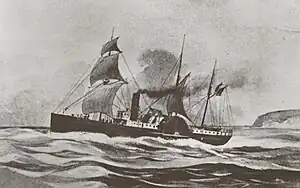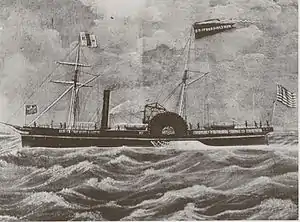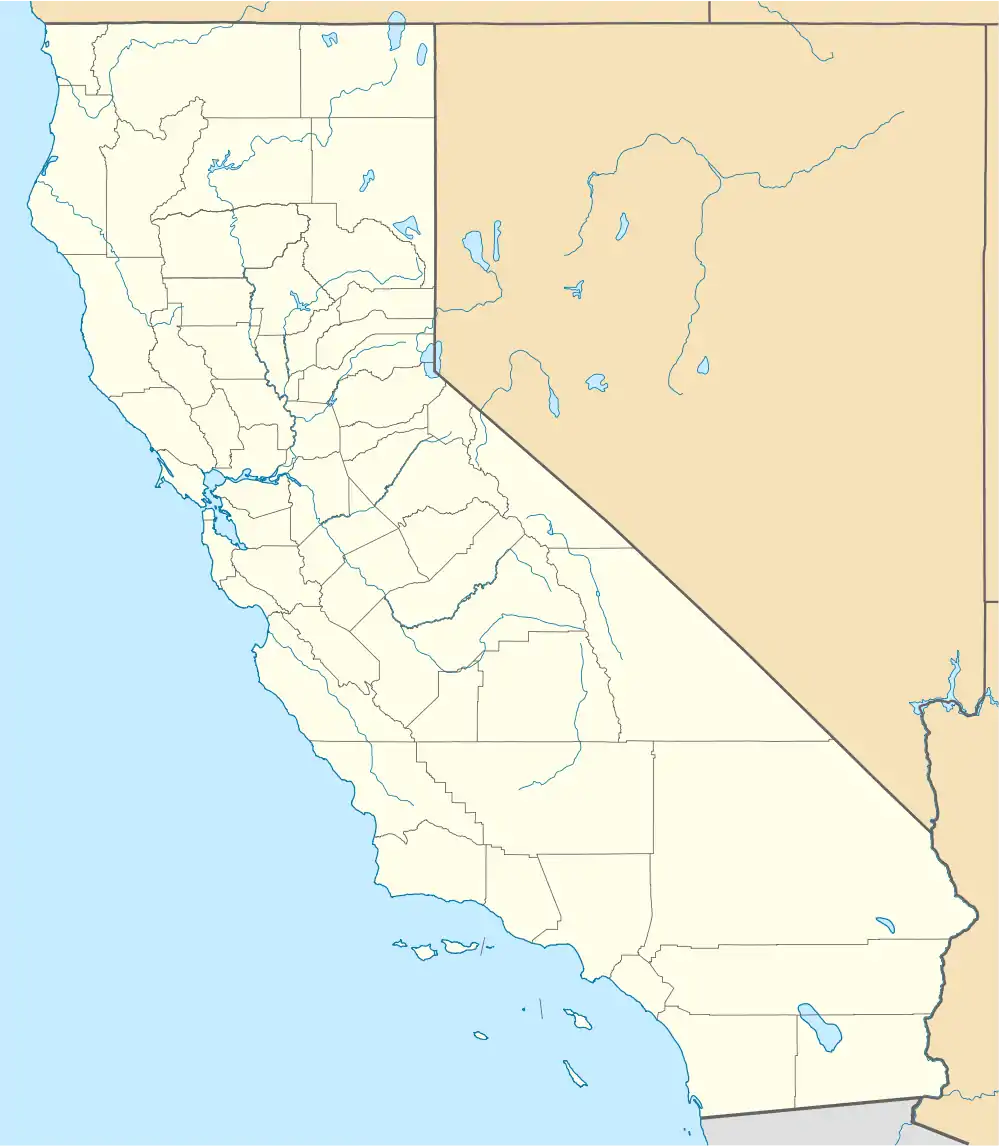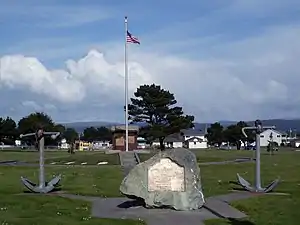 Brother Jonathan after the 1861 refit | |
| History | |
|---|---|
| Name |
|
| Namesake | Brother Jonathan |
| Owner |
|
| Completed | 1851 |
| Fate | Wrecked July 30, 1865 |
| General characteristics | |
| Tonnage | 1359 52/95 tons burthen |
| Length | 220 ft 11 in (67.34 m) |
| Beam | 36 ft (11 m) |
| Depth | 21 ft (6.4 m) |
| Sail plan | barkentine |
Brother Jonathan (Shipwreck Site) | |
 Brother Jonathan in 1851 | |
 | |
| Location | About 4.5 mi (7.2 km) SW of Point St. George |
| Nearest city | Crescent City, California |
| NRHP reference No. | 02000535 |
| CHISL No. | 541[2] |
| Added to NRHP | May 21, 2002 |
Brother Jonathan was a paddle steamer that struck an uncharted rock near Point St. George, off the coast of Crescent City, California, on July 30, 1865. The ship was carrying 244 passengers and crew, with a large shipment of gold. Only 19 people survived, making it the deadliest shipwreck up to that time on the Pacific Coast of the United States. Based on the passenger and crew list, 225 people are believed to have died. Its location was not discovered until 1993 and a portion of the gold was recovered in 1996.[3][4] The ship was also instrumental in setting off the 1862 smallpox epidemic in the Pacific Northwest, which killed thousands of Indigenous people in the region.
Initial construction
The ship was built by Perrine, Patterson, and Stack in Williamsburg, Brooklyn, and launched on November 2, 1850.[5][6] It was commissioned by Edward Mills, a New Yorker who tried to operate a shipping business during the California Gold Rush,[5] and was named after Brother Jonathan, a character personifying the region of New England. When built in 1851, it was 220 feet 11 inches (67.34 m) long and 36 ft (11 m) wide.[7] Its route was from New York to Chagres, Panama, and on its first journey it set a record for the then-fastest round-trip – 31 days.[8] Passengers would cross the Isthmus of Panama and make their way north to California via another ship.[5]
In 1852 the ship was purchased by Cornelius Vanderbilt, who operated a competing line, to replace one of his ships that had been wrecked. Vanderbilt had Brother Jonathan sail around Cape Horn and used it on the Pacific side of the route. Vanderbilt also had the steamer modified to accommodate more passengers.[9]
Uses

Vanderbilt's company had had an exclusive contract ferrying passengers across the isthmus through Nicaragua, but in 1856 the Nicaraguan government cancelled the agreement. The ship was then sold to Captain John Wright, renamed Commodore and put on West Coast routes, including from its new home port of San Francisco to British Columbia, as gold prospectors travelled to the Fraser Canyon Gold Rush.[10]
The ship played a small but symbolic role in the history of the state of Oregon. After President James Buchanan signed the bill admitting Oregon to the Union on February 14, 1859, the news was wired to St. Louis, carried by stagecoach to San Francisco, and loaded on Commodore on March 10. On March 15, the ship docked in Portland, delivering the official notification of statehood to the people of Oregon.[11]
By 1861, the ship had fallen into disrepair and was sold again to the California Steam Navigation Company, who retrofitted it, restored the original name of Brother Jonathan, and kept it on the northward route from San Francisco to Vancouver via Portland, allowing prospectors to work the Salmon River Gold Rush. Over the next several years, the vessel gained a reputation as being one of the finest steamers on the Pacific Coast, being the fastest ship to make the run, sixty-nine hours each way.[lower-alpha 1]
However, in the summer of 1865 the ship suffered a collision with a barkentine on the Columbia River, damaging the hull. Captain Samuel DeWolf, who had just assumed command of the vessel in June, recommended that the ship be repaired in dry dock, but the company performed the repairs while still in the water, as there was so much business that a backlog of cargo began to form.[10]
1862 smallpox epidemic
When Brother Jonathan traveled north from San Francisco and arriving in Victoria, British Columbia, on 12 March 1862, it brought along a miner infected with smallpox. When the disease began to infect indigenous people camped around Victoria, colonial authorities forced them to leave but as they made their return trip home, they spread the disease throughout the Salish Sea area and Pacific Northwest, from Puget Sound to southern Alaska. According to historian John Lutz, "The citizens of Victoria, one could say, panicked. Or, one could say, with a less charitable view, that they deliberately drove the Indigenous people out of town, and that spread the disease back to their home communities up and down the coast."[13]
Estimates of the death toll vary. Portland State University anthropologist Robert T. Boyd suggests that, by the end of 1862, 14,000 indigenous people along the coast had died from the outbreak.[14] Other estimates suggest that, over the next year, at least 30,000 indigenous people in the region died.[13] At least half of the population of indigenous peoples along the coast died, leaving behind "mass graves, deserted villages, traumatized survivors and societal collapse" that facilitated the colonization of the area.[13]
Shipwreck
On its last voyage, the ship had been heavily loaded and according to DeWolf's widow, he felt that the ship sat too low in the water, even without the passengers, but he was told that if he did not set sail, he would be fired and replaced by someone else. When it came time to depart, the bottom of the ship had sunk into the mud and they had to wait until high tide for a tugboat to pull her out.[15] However, later historians determined that the actual load was no more than 700 tons, well below its 900-ton carrying capacity.[16][17]
Within hours of leaving San Francisco Bay for Portland and Victoria, it ran into a gale. Most of the passengers became seasick and stayed in their cabins. Early on Sunday morning, July 30, 1865, the steamer anchored in Crescent City harbor on the first leg of its trip. After leaving the safety of the bay that Sunday afternoon, the ship encountered more stormy conditions.[10] The seas were so bad near the California / Oregon border that the captain ordered the ship turned around for the harbor of Crescent City. Fifty-five minutes later on that return and close to port, the ship struck a rock, tearing a large hole in the hull.[18] A heavy ore crusher had been loaded in the cargo hold directly above the portion of the hull that had been repaired a month earlier and smashed through it as well. Within five minutes, the captain realized the ship was foundering and ordered the passengers and crew to abandon ship.[10]
Although there were enough lifeboats to hold all of the people on board, only three boats could be deployed. Acts of courage and desperation, fear and self-sacrifice, were numerous.[3][4][19][20][21][22] The rough waves capsized the first lifeboat that was lowered and smashed the second against the vessel's sides. Only a single surfboat, holding eleven crew members, five women, and three children, managed to escape and make it safely to Crescent City. Four boats in the harbor tried to reach the sinking ship but were forced to turn back by the storm.[10]
Among the victims were:[23]
- Brigadier General George Wright, the former Union Commander of the Department of the Pacific, now on his way to take over the Department of the Columbia
- Dr. Anson G. Henry, Surveyor General of the Washington Territory, who was also Abraham Lincoln's physician and close friend
- James Nisbet, a well-known publisher, who wrote a love note and his will while awaiting his death
- Roseanna Keenan, a colorful San Francisco madam, who was travelling with seven "soiled doves"
- William Logan, who was appointed superintendent of The Dalles Mint in Oregon and whose death was partially responsible for the mint's failure to begin operating.
For its final voyage, crates of gold coins had been loaded on the vessel, including the annual treaty payments in gold for Indian tribes, Wells Fargo shipments consigned for Portland and Vancouver, and gold carried on board by the passengers. A large ship's safe safeguarded jewelry, more gold coins, and gold bars. The gold alone was valued at $50 million in today's dollars.[lower-alpha 2] Divers and ships began searching for the sunken treasure two weeks after the disaster, but despite the attempts of numerous people, for over 125 years, the ship's treasure of gold and artifacts were not found, although a fisherman in the 1930s claimed to have found 22 pounds (10.0 kg) of gold bars from the wreck in his nets.[26] As it was illegal to own gold bars at the time due to Executive Order 6102, he kept the discovery a secret until 1974 when he sold them.[27]
Modern recovery efforts

Despite the fact that Brother Jonathan sank just 8 miles (13 km) from Crescent City, the storms, rocky passageways, underwater currents, and underwater darkness prevented it from being found. Technology needed to improve and explorers had to change their assumptions before the ship could be found. On the last day of their 1993 expedition, men involved with Deep Sea Research (DSR) decided that the ship had drifted underwater to hit bottom 2 miles (3 km) from where it smashed into the rock. Led by Donald Knight (whose father had found a piece of the wreckage),[28] and under risky conditions, a mini-sub on October 1, 1993, discovered the ship in the predicted location.[29] Over time, the team began to bring artifacts back from a depth of 275 feet (84 m).
In 1996, a mini-sub passed a "glint" on the bottom, raising curiosity. On August 30, 1996, divers found 875 gold coins from the 1860s in near-mint condition. Over time, the salvors recovered 1,207 gold coins, primarily $20 double eagles.
Among the thousands of other items eventually raised were 19th-century cut-crystal sherry glasses, white porcelain plates, beer mugs, terracotta containers (once holding mineral water from Germany), glassware, cups, glass containers, multi-faceted cruet bottles, wine and champagne bottles, crates of goods (including axe handles and doorknobs) and tinctures of medicine.[3][4][30][31][32]
While recovery efforts were being conducted, lawsuits abounded involving the salvors, the State of California, and numismatic experts. California took the legal position that it owned the rights to the wreck and everything located close to its shores. As the state had enacted a broad law granting it these rights to "historical shipwrecks", it fought the salvor's claims of ownership. Although every judge along the way disagreed with California's position, a number of states with similar interests joined in the legal battle. Finally, the U.S. Supreme Court in 1998 unanimously held that existing federal law held precedence, declared the state's law(s) unconstitutional, and ruled for the salvors.[33][34][35][36][37][38][39][40] However, California officials told DSR that they would take the fight up again to the Supreme Court on the facts, and the state received 20 percent of the recovered gold in a final settlement,[41] as well as ownership of the wreck itself.[42]
In the first legally-recognized sale of all of the salvors' gold discovered from a sunken treasure ship, more than 500 bidders attended the auction of DSR's gold coins on May 29, 1999, in Los Angeles.[43][44] The sale of its 1006 coins fetched a total of $6.3 million.[29]
Meanwhile, another debate had broken out over the authenticity of the gold bars recovered in the 1930s and sold in 1974. Numismatic experts attacked each other over the authenticity of the bars in a rare public controversy at the 1999 American Numismatic Association's annual convention. This also resulted in litigation.[45]
Legacy

As a result of the shipwreck, laws were passed to improve passenger-ship safety, including the ability of lifeboats to be launched from a sinking ship.[46][47]
It also resulted in approval to build the St. George Reef Lighthouse, though construction was not completed until 1892.[48]
A memorial for the deceased, registered as California Historical Landmark No. 541, sits at Brother Jonathan Vista Point in Crescent City. The shipwreck is listed in the National Register of Historic Places.[lower-alpha 3]
Deep Sea Research set up a conservation lab for the recovered artifacts that was run by the local historical society in Crescent City, the Del Norte County Historical Society. The salvors also hired national experts including numismatists Robert R. Johnson, Ronald F. Umile, and Konstantin Balter to work with the volunteers in these efforts.[32][50] This small historical society has been refurbishing and maintaining the artifacts, as well as having an exhibit on Brother Jonathan's demise and a variety of the objects that were reclaimed.[51] The ship's wheel can be found in a restaurant in Portland.[26]
Despite the gold coins already discovered and brought up, crates of gold from Brother Jonathan still remain hidden and undisturbed. The large safe with its millions of dollars of jewels, gold bars, and gold was never found. The salvors estimate that four-fifths of the treasure is still waiting to be discovered—mere miles from land.[24][25]
On the 150th anniversary of the shipwreck, the Idaho Civil War Round Table held a special commemorative program honoring the victims and survivors of the tragedy where the Brother Jonathan 150th anniversary website was unveiled.[52]
Notes
- ↑ Other than Powers and Bowers above, a detailed history of Brother Jonathan is found generally at Lomax.[12] See also, "Brother Jonathan Began Life on East Coast, Sank in 1865". The Daily Triplicate. September 16, 2000. p. 9A.
- ↑ By count of the coins discovered and those brought on board just in crates, only twenty percent of the gold, at best, was discovered. Not including the large Dobler safe, this translates into a $40 million valuation of gold on board by itself.[24] When including the safe, estimates are even higher, including one of $108 million.[25]
- ↑ The listing of the shipwreck in the National Register of Historic Places was part of the litigation efforts by California.[49]
References
- ↑ "Brother Jonathan Cemetery". Office of Historic Preservation, California State Parks. Retrieved September 5, 2012.
- ↑ "Brother Jonathan Cemetery". Office of Historic Preservation, California State Parks. Retrieved September 5, 2012.
- 1 2 3 Powers 2006.
- 1 2 3 Bowers 1999.
- 1 2 3 Delgado 1995, p. 8-2.
- ↑ Colton, Tim (March 22, 2020). "Perrine, Patterson, and Stack". Shipbuilding History. Retrieved July 31, 2021.
- ↑ Delgado 1995, p. 7-1.
- ↑ Walker 1999, p. 1.
- ↑ Delgado 1995, p. 8-3.
- 1 2 3 4 5 Walker 1999, p. 2.
- ↑ Powers, Dennis M. "Brother Jonathan (ship)". The Oregon Encyclopedia. Retrieved May 17, 2014.
- ↑ Lomax, Alfred L. (September 1959). Brother Jonathan: Pioneer Steamship of the Pacific Coast. Vol. 60. Oregon Historical Society.
- 1 2 3 Ostroff, Joshua (August 1, 2017). "How a smallpox epidemic forged modern British Columbia". Maclean's.
- ↑ Lang, Greg. "Smallpox kills 14,000 Northwest Coast Indians from April to December 1862". www.historylink.org.
- ↑ DeWolf 1900.
- ↑ Powers 2006, p. 10.
- ↑ Bowers 1999, pp. 255–257.
- ↑ Delgado 1995, p. 8-5.
- ↑ "Told by A Survivor, the Wreck of the Brother Jonathan. Mrs. Mary Altrie's Vivid Recollection". San Francisco Chronicle. February 11, 1894.
- ↑ "A Sea Tragedy: The Brother Jonathan Wreck Revived". Del Norte Record. February 2, 1892.
- ↑ Chase, Doris (December 13, 1959). "The Brother Jonathan Shipwreck Spelled an End to 'Coffin Ships'". The Humboldt Times. p. 12.
- ↑ "Full Particulars of the Wreck of the Brother Jonathan". Alta California. August 10, 1865.
- ↑ "Brother Jonathan Passenger List" (PDF). The Brother Jonathan Shipwreck Exhibit. California State Lands Commission. 1999. Retrieved July 28, 2020.
- 1 2 Powers 2006, pp. 10–11.
- 1 2 Emert 1999.
- 1 2 John, Finn J. D. (January 9, 2011). "Shipwreck of Brother Jonathan is ground zero in treasure squabble". Offbeat Oregon History. Retrieved July 28, 2020.
- ↑ Gaines, W. Craig (2008). Encyclopedia of Civil War Shipwrecks. LSU Press. pp. 26–27. ISBN 978-0-8071-3424-5.
- ↑ Franks, Jonathan (June 1996). "Treasure Hunt". Boys' Life. pp. 38–41.
- 1 2 Dwyer, A. C. "Shipwreck Treasure of S.S. Brother Jonathan | Page 2". acdwyer.com. Retrieved July 29, 2020.
- ↑ McKenzie-Bahr, Mike (September 6, 1997). "Shipwreck Artifacts Come to Surface". The Daily Triplicate.
- ↑ Sowden, Carrie E.; Dewolf, Helen; Hamilton, Donny L. (2001). "A chest from the Brother Jonathan shipwreck". Conservation Research Laboratory Reports. Conservation Research Laboratory, Texas A & M. Retrieved February 10, 2008.
- 1 2 Report of Field Activities on the Brother Jonathan, Submerged Cultural Resource Site, Crescent City, California, August 18–31, 1997. Deep Sea Research and R2 Consultants.
- ↑ California v. Deep Sea Research, 523 U.S 491 (U.S. April 22, 1998).
- ↑ Clifford, James O. (February 12, 1996). "Is there Gold in the Deep?: Court Fight Continues over 1865 Shipwreck of Brother Jonathan". Associated Press.
- ↑ Chiang, Harriet (March 19, 1999). "Finders Keepers; Treasure Hunters will be Able to Keep the Gold Found on a Shipwreck off Crescent City". San Francisco Chronicle. p. A19.
- ↑ Jones, John Paul (April 1999). "The United States Supreme Court and Treasure Salvage: Issues Remaining after Brother Jonathan". Journal of Maritime Law & Commerce. 30: 205.
- ↑ Lorello, D. David Jr. (2000) [1999]. "The Abandoned Shipwreck Act of 1987: Navigating Through the Fog". Gonzaga Law Review. 35: 75.
- ↑ Paddock, Richard C. (March 17, 1996). "Treasure or Time Capsule?: Ex-Partners Are at Odds". Los Angeles Times. p. A-1.
- ↑ Griffith, John (September 27, 1996). "Squabbling Over a Shipwreck". The Oregonian. p. D8.
- ↑ Powers 2006, pp. 233–250.
- ↑ "DANGER AT BROTHER JONATHAN POINT". Crescent City Times. December 14, 2016. Retrieved July 29, 2020.
- ↑ California State Lands Commission, Kelley, Roger E.; Franklin, Gary (eds.), "The Brother Jonathan: A California Treasure Ship" (PDF), Along the Shores of Time, pp. 67–70, retrieved July 28, 2020
- ↑ "California Gold Pieces Go on Sale". The Columbus Dispatch. June 6, 1999. p. 6K.
- ↑ Powers 2006, pp. 313–323.
- ↑ Powers 2006, pp. 324–347, Chapter 17.
- ↑ Powers 2006, pp. 133–135.
- ↑ United States Coast and Geodetic Survey. Annual Report of the Superintendent (Benjamin Peirce) of the U.S. Coast and Geodetic Survey, 1869–1870, Ex. Doc. No. 206, 41 Congress, 2nd Session; also, United States Printing Office. Acts of Congress Relating to Steamboats. Washington: Government Printing Office, 1867.
- ↑ Powers, Dennis M (2007). Sentinel of the Seas: Life and Death at the Most Dangerous Lighthouse Ever Built. Citadel. p. 288. ISBN 978-0806528427.
- ↑ Powers 2006, pp. 255–256.
- ↑ Powers 2006, pp. 380–385.
- ↑ "The S.S. Brother Jonathan". Del Norte County Historical Society. Retrieved July 29, 2020.
- ↑ "150th Anniversary of the wreck of the Brother Jonathan on 30 July 2015". Archived from the original on October 21, 2017. Retrieved October 21, 2017.
Bibliography
- "Del Norte". California Historical Landmarks. Office of Historic Preservation. Retrieved August 29, 2005.
- Bowers, Q. David (1999). The Treasure ship S.S. Brother Jonathan: Her Life and Loss, 1850–1865. Wolfeboro, New Hampshire: Bowers and Merena Galleries, Inc. ISBN 978-0943161815.
- Delgado, James P. (1995). "National Register of Historic Places Registration Form / Brother Jonathan" (PDF). National Park Service. Retrieved October 7, 2012.
- DeWolf, Maria (Knight) (March 19, 1900), Handwritten biography and stories on file at the Del Norte Historical Society, Crescent City, California
{{citation}}: CS1 maint: location missing publisher (link) - Emert, Phyllis Raybin (April 1999). "California's Golden Tragedy". East Bay Monthly. Oakland, California.
- Powers, Dennis (2006). Treasure Ship: The Legend and Legacy of the S.S. Brother Jonathan. New York, New York: Kensington/Citadel Press.
- Walker, Goodyear (1999). "We'll Find a New Captain..." (PDF). The Brother Jonathan Shipwreck Exhibit. California State Lands Commission. Retrieved July 28, 2020.
- United States Printing Office. Acts of Congress Relating to Steamboats. Washington: Government Printing Office, 1867.